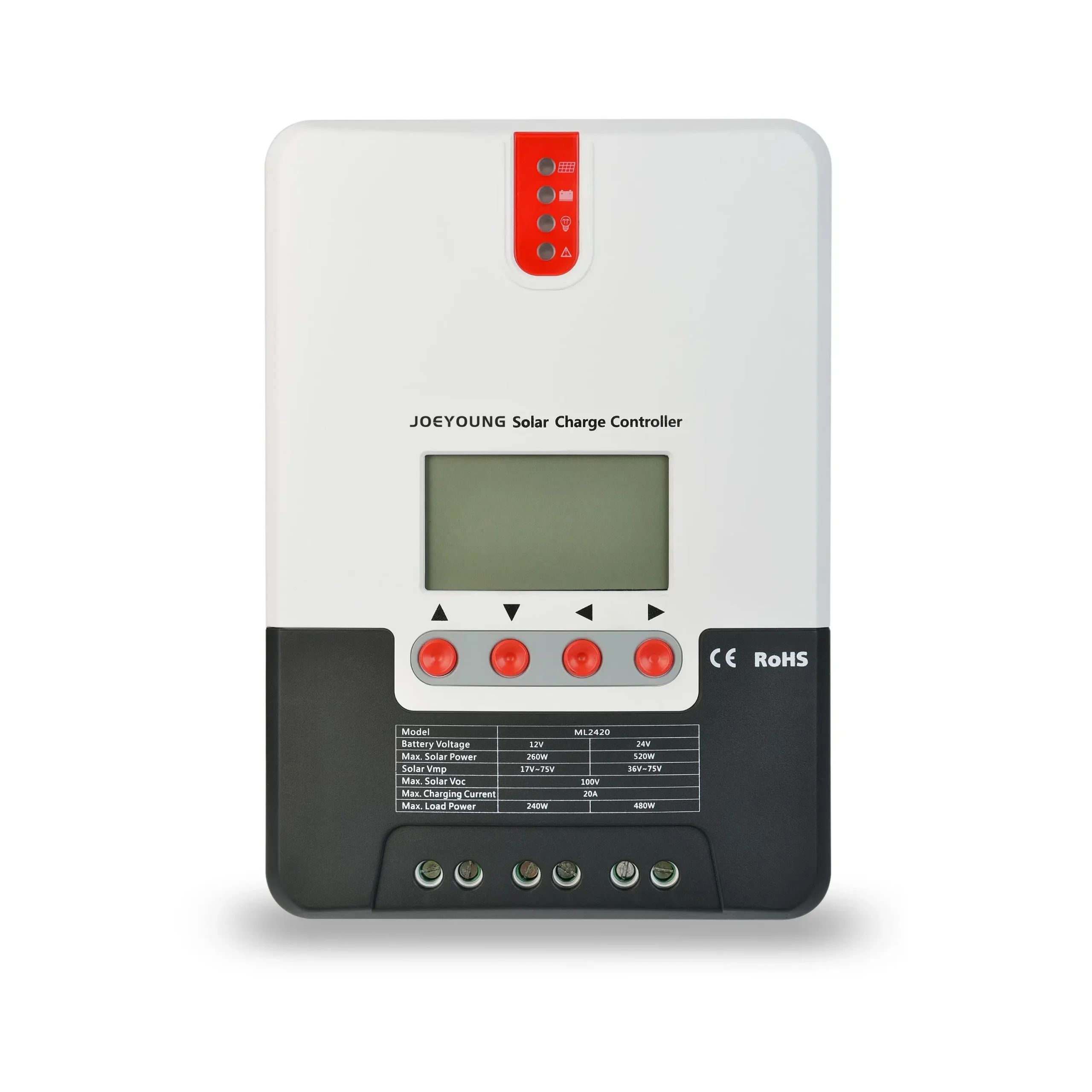







MPPT Solar Charge Controller (20/30/40 Amp) - PV System Tracker (DML Series)
- DML Series, PV100~150V, 20-60A, 12/24/48Vdc, MPPT Solar Charge Controller
DML PV 20/30/40 Amp Charger, equipped with advanced MPPT technology, accurately tracks the maximum power point of solar panels and improves energy conversion efficiency. Intelligent control system, one-button operation, easy charging management, protect battery safety. 20A, 30A, 40A multiple specifications are available to meet different needs. Compact design, easy installation, widely compatible with various solar panels and batteries.
- Multiple specifications available, 20A, 30A, 40A charging currents are available
- Intelligent control
- Wide compatibility
- Wide voltage automatic identification
- Product adapter interface, 24V and 48V products are equipped with RS232 interface, and 48V products also have RS485 interface.

- With LCD Display
LED fault indicators and an LCD screen which can display abnormality information help users to quickly identify system faults.

- With DC Output Terminal
Comes with a DC output terminal, making it convenient to directly connect and use DC devices.

- 24/48V Products With RS232/485
The 24V/48V products feature RS232/485 communication interfaces, enhancing the system’s remote management and data transmission capabilities.
| Electric Parameters | |||
|---|---|---|---|
| Parameter | Value | ||
| Model | DML-MPPT-20A | DML-MPPT-30A | DML-MPPT-40A |
| System voltage | 12V/24VAuto | ||
| No-load loss | 0.7 W to 1.2W | ||
| Battery voltage | 9V to 35V | ||
| Max. solar input voltage | 100V(25℃) 90V(-25℃) | ||
| Max. power point voltage range | Battery Voltage+2V to 75V | ||
| Rated charging current | 20A | 30A | 40A |
| Rated load current | 20A | ||
| Max. capacitive load capacity | 10000uF | ||
| Max. photovoltaic system input power | 260W/12V 520W/24V | 400W/12V 800W/24V | 520W/12V 1040W/24V |
| Conversion efficiency | ≤98% | ||
| MPPT tracking efficiency | >99% | ||
| Temperature compensation factor | -3mv/℃/2V(default) | ||
| Operating temperature | -35℃ to +45℃ | ||
| Protection degree | IP32 | ||
| Weight | 1.4Kg | 2Kg | 2Kg |
| Communication method | RS232 | ||
| Altitude | ≤ 3000m | ||
| Product dimensions | 210*151*59.5mm | 238*173*72.5mm | 238*173*72.5mm |
| Battery Type Default Parameters (parameters set in monitor software) | ||||
|---|---|---|---|---|
| Parameters cross-reference table for different types of batteries | ||||
| Voltage to set Battery type | Sealed lead-acid battery | Gel lead-acid battery | Open lead-acid battery | User (self-customized) |
| Over-voltage cut-off voltage | 16.0V | 16.0V | 16.0V | 9~17V |
| Equalizing voltage | 14.6V | —— | 14.8V | 9~17V |
| Boost voltage | 14.4V | 14.2V | 14.6V | 9~17V |
| Floating charging voltage | 13.8V | 13.8V | 13.8V | 9~17V |
| Boost return voltage | 13.2V | 13.2V | 13.2V | 9~17V |
| Low-voltage cut-off return voltage | 12.6V | 12.6V | 12.6V | 9~17V |
| Under-voltage warning return voltage | 12.2V | 12.2V | 12.2V | 9~17V |
| Under-voltage warning voltage | 12.0V | 12.0V | 12.0V | 9~17V |
| Low-voltage cut-off voltage | 11.1V | 11.1V | 11.1V | 9~17V |
| Discharging limit voltage | 10.6V | 10.6V | 10.6V | 9~17V |
| Over-discharge time delay | 5s | 5s | 5s | 1~30s |
| Equalizing charging duration | 120minutes | —— | 120minutes | 0~600minutes |
| Equalizing charging interval | 30days | 0days | 30days | 0~250D (0 means the equalizing charging function is disabled) |
| Boost charging duration | 120minutes | 120minutes | 120minutes | 10~600minutes |
Yes, DML PV Charger has built-in reverse battery protection function, which can effectively prevent equipment damage caused by reverse battery connection.
Regularly check whether the charger's connection line and interface are loose or damaged, keep the device clean and dry, and avoid using it in harsh environments.
DML PV Charger supports various types of solar panels, including but not limited to monocrystalline silicon, polycrystalline silicon and amorphous silicon.








